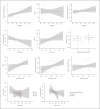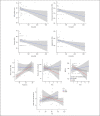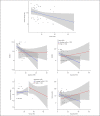Biological and Psychological Stress Correlates Are Linked to Glucose Metabolism, Obesity, and Gender Roles in Women
- PMID: 33461207
- PMCID: PMC8985024
- DOI: 10.1159/000514484
Biological and Psychological Stress Correlates Are Linked to Glucose Metabolism, Obesity, and Gender Roles in Women
Abstract
Objectives: Psychological stress affects central as well as peripheral metabolism and hormone trafficking via the hypothalamic-pituitary-adrenal axis. Stress thereby plays a decisive role in the etiology and progression of overweight and obesity, leading to several chronic diseases, such as diabetes, and mental health disorders. The interplay of biological and psychometric correlates of stress, anthropometric, immunological, and metabolic parameters and psychosocial factors such as gender roles, however, remains poorly understood.
Methods: In this exploratory study, 43 healthy women were assessed for glucose metabolism by an oral glucose tolerance test and computation of functional parameters for insulin secretion, sensitivity, and resistance. Further, the fatty liver index (FLI) and anthropometric parameters body mass index (BMI), waist-to-hip ratio, body fat, and lean mass were assessed. Psychological stress assessment included the "Brief Symptom Inventory" (BSI), the "Burnout Dimensions Inventory" (BODI), and Perceived Stress Scale (PSS). Biological stress response was evaluated with heart rate variability and cortisol levels. Finally, gender role self-identification was assessed with the "Bem Sex-Role Inventory" (BSRI). Generalized linear models were computed for exploratory association with psychometric outcome. Uncorrected p values are reported.
Results: Burnout and PSS scores were associated with insulin secretion, sputum cortisol, thyroid-stimulating hormone, anthropometric measures, and gender role. BSI ratings for psychiatric symptom dimensions were associated with insulin resistance, sex hormones, anthropometric measures, and gender role. Female self-identification was associated with higher BMI as well as body fat and a higher FLI.
Conclusions: Considering the increased risk of unfavorable metabolic, cardiovascular, and also mental health outcome in obese women, a higher BMI in women with predominant female gender self-identification may be relevant for clinical risk assessment. The broad range of interacting biological, psychological, and gender-related parameters calls for an integrative management of both mental and endocrinological health. However, the exploratory nature of the study requires replication in larger samples before definite conclusion can be drawn.
Keywords: Insulin trafficking; Obesity; Stress.
© 2021 The Author(s) Published by S. Karger AG, Basel.
Conflict of interest statement
The authors have no conflicts of interest to declare.
Figures




Similar articles
-
Hypothalamic-pituitary-adrenal axis function: relative contributions of perceived stress and obesity in women.J Womens Health (Larchmt). 2008 Dec;17(10):1647-55. doi: 10.1089/jwh.2008.0866. J Womens Health (Larchmt). 2008. PMID: 19049359 Free PMC article.
-
Pythagorean self-awareness intervention: A novel cognitive stress management technique for body weight control.Eur J Clin Invest. 2019 Oct;49(10):e13164. doi: 10.1111/eci.13164. Epub 2019 Sep 16. Eur J Clin Invest. 2019. PMID: 31421060 Clinical Trial.
-
Cortisol and ACTH response to oral dexamethasone in obesity and effects of sex, body fat distribution, and dexamethasone concentrations: a dose-response study.J Clin Endocrinol Metab. 2002 Jan;87(1):166-75. doi: 10.1210/jcem.87.1.8158. J Clin Endocrinol Metab. 2002. PMID: 11788642 Clinical Trial.
-
Occupational gender roles in relation to workplace stress, allostatic load, and mental health of psychiatric hospital workers.J Psychosom Res. 2021 Mar;142:110352. doi: 10.1016/j.jpsychores.2020.110352. Epub 2020 Dec 31. J Psychosom Res. 2021. PMID: 33450429
-
Body fat distribution, insulin resistance, and metabolic diseases.Nutrition. 1997 Sep;13(9):795-803. doi: 10.1016/s0899-9007(97)00191-3. Nutrition. 1997. PMID: 9290093 Review.
Cited by
-
Short Term Caloric Restriction and Biofeedback Enhance Psychological Wellbeing and Reduce Overweight in Healthy Women.J Pers Med. 2021 Oct 26;11(11):1096. doi: 10.3390/jpm11111096. J Pers Med. 2021. PMID: 34834448 Free PMC article.
-
A protein restricted diet induces a stable increased fat storage phenotype in flies.Toxicol Rep. 2023 Jun 7;10:706-713. doi: 10.1016/j.toxrep.2023.06.003. eCollection 2023. Toxicol Rep. 2023. PMID: 37396850 Free PMC article.
-
A prospective, observational clinical trial on the impact of COVID-19-related national lockdown on thyroid hormone in young males.Sci Rep. 2021 Mar 29;11(1):7075. doi: 10.1038/s41598-021-86670-9. Sci Rep. 2021. PMID: 33782499 Free PMC article. Clinical Trial.
-
A perspective on the role of physiological stresses in cancer, diabetes and cognitive disease as environmental diseases.Front Mol Biosci. 2023 Nov 20;10:1274221. doi: 10.3389/fmolb.2023.1274221. eCollection 2023. Front Mol Biosci. 2023. PMID: 38053578 Free PMC article.
-
Gender-specific impact of stress and adiposity on autonomic stress modulation in teachers.Front Psychol. 2025 May 1;16:1522686. doi: 10.3389/fpsyg.2025.1522686. eCollection 2025. Front Psychol. 2025. PMID: 40376486 Free PMC article.
References
-
- Danaei G, Finucane MM, Lu Y, Singh GM, Cowan MJ, Paciorek CJ, et al. National, regional, and global trends in fasting plasma glucose and diabetes prevalence since 1980: systematic analysis of health examination surveys and epidemiological studies with 370 country-years and 2.7 million participants. Lancet. 2011 Jul 2;378((9785)):31–40. - PubMed
-
- GBD 2015 Disease and Injury Incidence and Prevalence Collaborators Global, regional, and national incidence, prevalence, and years lived with disability for 310 diseases and injuries, 1990–2015: a systematic analysis for the Global Burden of Disease Study 2015. Lancet. 2016 Oct 8;388((10053)):1545–602. - PMC - PubMed
-
- Chooi YC, Ding C, Magkos F. The epidemiology of obesity. Metabolism. 2019 Mar;92:6–10. - PubMed
-
- Gregg EW, Sattar N, Ali MK. The changing face of diabetes complications. Lancet Diabetes Endocrinol. 2016 Jun;4((6)):537–47. - PubMed
MeSH terms
LinkOut - more resources
Full Text Sources
Other Literature Sources
Medical

